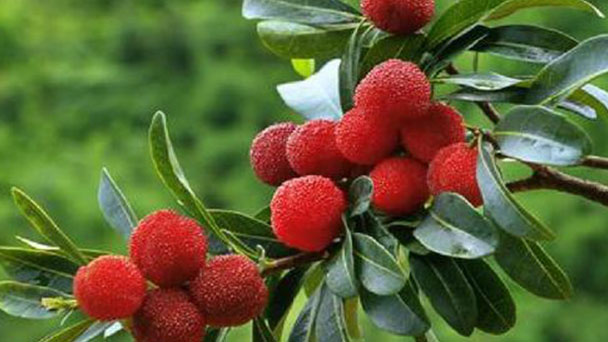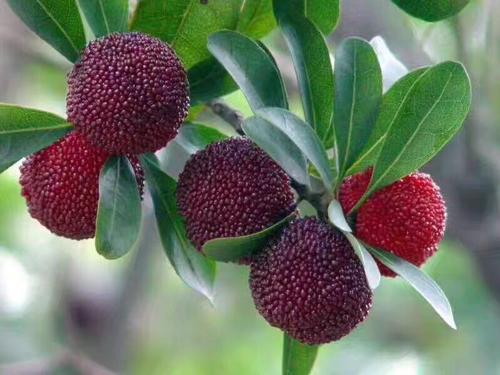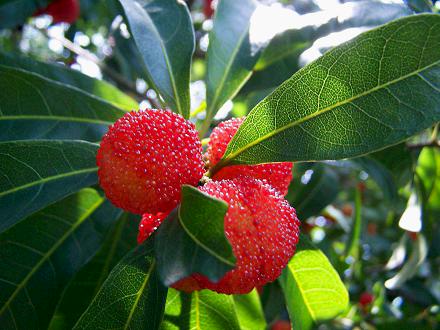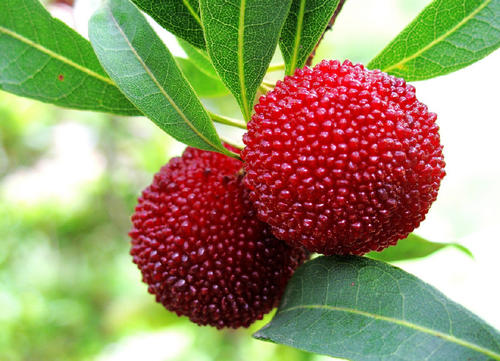Chinese Bayberry Profile
Written by Maggie
Nov 08 2021

Chinese Bayberry evergreen fruit trees, for China's specialty fruit trees. Fruit's unique flavor, bright color, juice, high nutritional value, sugar content 12 ~ 13%, acid content 0.5 ~ 1.8%, rich in vitamin C. The potassium content of Chinese Bayberry fruit is the highest among all fruits, and the potassium content of fresh fruit is 1410.0 mg/kg. In particular, Chinese Bayberry is mature in early summer, which can fill the market vacancy and is an important fresh fruit in season.
Chinese Bayberry Picture

Characteristics of Chinese Bayberry
Chinese Bayberry is an evergreen shrub or small trees.bBark is gray; Branchlets are nearly glabrous. Leaves are leathery, obovate-lanceolate or ovate-oblong, 6 -- 11 cm long, 1.5 -- 3 cm wide, entire, abaxially densely golden-yellow glands. Flowers of chinese bayberry are unisexual heterotropies; Male inflorescence is spicate, solitary or several fascicular leaf axils, 1 -- 2 cm long; Bracteoles are semicircular, stamens 4 -- 6; Female inflorescences of Chinese Bayberry are solitary leaf axils, 5 -- 15 mm long, densely imbricate bracts, each with 1 female flower, female flower with 4 bracteoles; Ovary is ovate. Drupe of Chinese Bayberry is spherical, 10-15 mm in diameter, a small wart protuberance, ripe crimson, purple into white, sweet and sour taste. Flowering period of Chinese bayberries is in April, fruiting in June - July.
Chinese Bayberry Distribution
Chinese Bayberry is native to the mountainous areas with temperate and subtropical humid climate in China. It is mainly distributed in the south of the Yangtze River Basin and the north of Hainan Island, that is, between 20℃ and 31℃ north latitude. Chinese Bayberry is similar to citrus, loquat, tea tree and bamboo, but it's cold resistance is stronger than that of citrus and loquat.
At present, the provinces carrying Chinese Bayberry in China are Yunnan, Guizhou, Zhejiang, Jiangsu, Fujian, Guangdong, Hunan, Guangxi, Jiangxi, Sichuan, Anhui, Taiwan, etc., among which Zhejiang has the largest cultivation area, the best variety quality, and the highest yield.Next came Jiangsu, Fujian and Guangdong. Awide, such as Japan and South Korea have a small number of cultivation, Southeast Asian countries, such as India, Myanmar, Vietnam, the Philippines and other countries also have distribution, but because of its small fruit shape, sour taste, more planted in the courtyard for viewing, or for sugar food, not as an economic fruit tree cultivation. Therefore, Chinese Bayberry is a characteristic fruit in southern China.

Chinese Bayberry Growing Environment
Chinese Bayberry grows in mountains and hills, with tall canopy, good humidity and shade tolerance. The temperature requirement of Chinese bayberries is 15℃ to 30℃, and the red and yellow loose soil with slightly acidic soil and silica gravel sand is the most appropriate.
Chinese Bayberry Value
Nutritional Value
The high quality Chinese Bayberry pulp contains 12% ~ 13% sugar and 0.5% ~ 1.1% acid. Chinese Bayberry is rich in cellulose, mineral elements, vitamins and a certain amount of protein, fat, pectin and 8 kinds of amino acids beneficial to the human body. The content of calcium, phosphorus and iron in the fruit is more than 10 times higher than that of other fruits.
Medicinal Value
Chinese Bayberry whole body is treasure, flat, non-toxic, fruit, nucleus, root, skin can be used as medicine, Chinese Bayberry leaves have Chinese Bayberry flavonoids with astringent, stimulant, emetic effect, for diarrhea, jaundice hepatitis, lymphatic tuberculosis and other diseases have a certain effect. Chinese Bayberry bark has antioxidant properties, can eliminate free radicals, soak wine can treat injuries, swelling pain and so on.
Healthcare Value
Chinese Bayberry is suitable for patients with stomach ache, dysphoria, acute gastroenteritis and dysentery. Chinese Bayberry is suitable for patients with oral pharyngitis to eat, suitable for obese people to eat, cancer patients and after radiotherapy and chemotherapy; Chinese Bayberry is suitable for patients with habitual constipation.

Latest Updated
- Benefits of Bugleweed - 7 Science-backed Health Benefits
- Bugleweed Dangers & Side Effects - Is It Poisonous?
- How to Plant Evergreen Trees - What You Should Know
- When to Plant Evergreens - Grow Guide for Evergreen Trees
- 12 Wonderful Evergreen Shrubs for Your Garden
- 12 Popular Evergreen Plants with Pictures for Beginners
- When And How To Prune A Lilac Bush Like a Pro
- How to Grow & Care for Lilac Vine (Hardenbergia Violacea)
- Japanese Lilac Tree (Syringa Reticulata) Care & Propagation Guide
- Shumard Oak Pros and Cons - What to Know
Popular Articles
- Winter maintenance of Antirrhinum Majus
- How to Grow Terminalia Mantaly Tree
- How to Grow and Care for Crossostephium Chinense
- How to grow Antirrhinum Majus in spring
- Peristeria Elata (Dove Orchid) Profile: Info & Care Guide
- Underwatered Snake Plant (Sansevieria Trifasciata) - Signs And How To Fix
- How to Care for Brazilian Jasmine Plant (Mandevilla Sanderi)
- How to Grow & Care for Graptopetalum Purple Delight in Summer
- Rosa Chinensis (China Rose): Plant Growing & Care Tips
- How to Care for Baby Sun Rose (Aptenia Cordifolia)